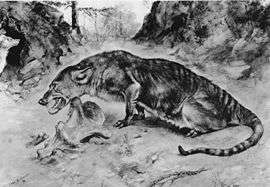Mesonychidae
| Mesonychidae Temporal range: Early Paleocene–Early Oligocene | |
|---|---|
 | |
| Harpagolestes immanis skull | |
| Scientific classification | |
| Kingdom: | Animalia |
| Phylum: | Chordata |
| Class: | Mammalia |
| Infraclass: | Eutheria |
| Superorder: | Laurasiatheria |
| Order: | Mesonychia |
| Family: | Mesonychidae Cope 1880[1] |
| Genera | |
|
See text | |
Mesonychidae ("Middle Claws") is an extinct family of small to large-sized omnivorous-carnivorous mammals closely related to cetartiodactyls (even-toed ungulates & cetaceans) which were endemic to North America and Eurasia during the Early Paleocene to the Early Oligocene.
Description
The mesonychids were an unusual group of condylarths with a specialized dentition featuring tri-cuspid upper molars and high-crowned lower molars with shearing surfaces. They were once viewed as primitive carnivores, like the Paleocene family Arctocyonidae, and their diet probably included meat and fish. In contrast to this other family of early mammals, the mesonychids had only four digits furnished with hooves supported by narrow fissured end phalanges. [2]
Evolutionary history
They first appeared in the Early Paleocene, undergoing numerous speciation events during the Paleocene, and Eocene. Mesonychids fared very poorly at the close of the Eocene epoch, with only one genus, Mongolestes,[3] surviving into the Early Oligocene epoch.

Mesonychids probably originated in Asia, where the most primitive mesonychid, Yangtanglestes, is known from the early Paleocene. They were also most diverse in Asia where they occur in all major Paleocene faunas. Since other carnivores such as the creodonts and condylarths were either rare or absent in these animal communities, mesonychids most likely dominated the large predator niche in the Paleocene of Asia. Throughout the Paleocene and Eocene, several genera, including Dissacus, Pachyaena and Mesonyx would radiate out from their ancestral home in Asia and into Europe and North America, where they would give rise to new mesonychid genera. These animals would have migrated to North America via the Bering land bridge.
The term "mesonychid" is often used to refer to any of the various members of the order Mesonychia, though most experts prefer to use it to refer to the members of the family Mesonychidae, with many experts using the term "mesonychian" to refer to the order as a whole.
Taxonomy
Mesonychidae was named by Cope (1880). It is not extant. Its type is Mesonyx. It was assigned to Creodonta by Cope (1880); to Creodonta by Cope (1889); to Carnivora by Peterson (1919); to Mesonychia by Carroll (1988) and Zhou et al. (1995); and to Cete by Archibald (1998);[4] and to Mesonychia by Carroll (1988), Zhou et al. (1995), Geisler and McKenna (2007) and Spaulding et al. (2009).[5]
Classification
Family Mesonychidae
- Genus Ankalagon
- A. saurognathus
- Genus Dissacus
- D. argenteus
- D. europaeus
- D. indigenus
- D. magushanensis
- D. navajovius
- D. praenuntius
- D. rotundus
- D. serior
- D. serratus
- D. willwoodensis
- D. zanabazari
- D. zengi
- Genus Guilestes
- G. acares
- Genus Harpagolestes
- H. immanis
- H. koreanicus
- H. orientalis
- Genus Hessolestes
- H. ultimus
- Genus Hukoutherium
- H. ambigum
- H. shimemensis
- Genus Jiangxia
- J. chaotoensis
- Genus Mesonyx
- Mesonyx nuhetingensis
- Mesonyx obtusidens
- Mesonyx uintensis
- Mesonyx uqbulakensis
- Genus Mongolestes
- M. hadrodens
- M. huangheensis
- Genus Mongolonyx
- M. dolichognathus
- M. robustus
- Genus Pachyaena
- P. gigantea
- P. intermedia
- P. ossifraga
- P. gracilis
- Genus Sinonyx
- S. jiashanensis
- Genus Synoplotherium
- S. vorax
- Genus Yangtanglestes
- Y. conexus
References
Notes
- ↑ E. D. Cope 1880 in the Paleobiology Database. Retrieved August 2013.
- ↑ Jordi & Anton 2002, p. 13
- ↑ Jin 2005
- ↑ J. D. Archibald. 1998. Archaic ungulates ("Condylarthra"). In C. M. Janis, K. M. Scott, and L. L. Jacobs (eds.), Evolution of Tertiary Mammals of North America 1:292-331
- ↑ Mesonychidae (condylarth) in the Paleobiology Database. Retrieved August 2013.
Cited sources
- Agusti, Jordi; Anton, Mauricio (2002). Mammoths, Sabertooths, and Hominids: 65 Million Years of Mammalian Evolution in Europe. Columbia University Press. ISBN 0-231-11640-3.
- Cope, E. D. (1880). "On the genera of the Creodonta". Proceedings of the American Philosophical Society. 19: 76–82. OCLC 45016526. Retrieved August 2013. Check date values in:
|access-date=(help) - Jin, Xun (2005). "Mesonychids from Lushi Basin, Henan Province, China" (PDF). Vertebrata PalAsiatica (in Chinese and English). 43 (2): 151–164. Retrieved August 2013. Check date values in:
|access-date=(help)